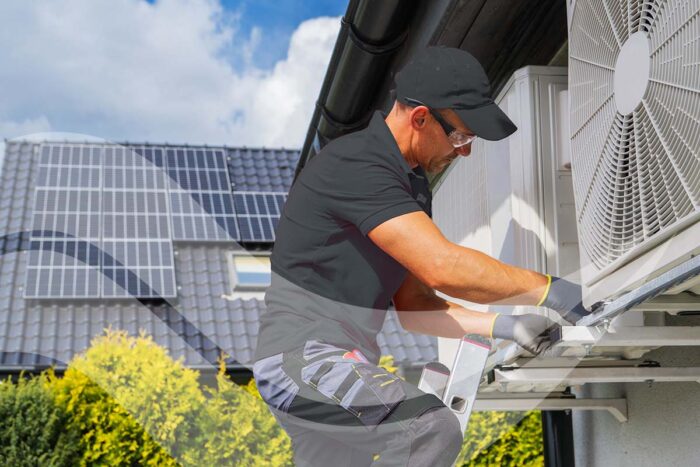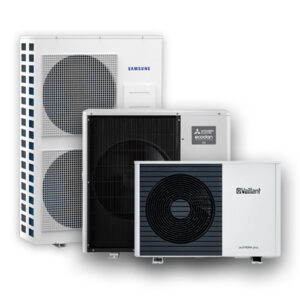Air Source Heat Pumps: Why Sizing is Crucial
Post by
Tony Dunn – Renewable Heat Sales Manager, CCL Components – 13/07/23

As we make the transition away from fossil fuels to renewable sources of heat and electricity, it’s important to understand that a change in heat source also means a change in design parameters.
When the industry was focused on gas and oil alone, it was relatively easy to size an appropriate boiler to ensure that each property had the right amount of heat and hot water. This was particularly the case with combi boilers. With a combi boiler providing hot water on demand, installers could take a broad-brush approach and size an appropriate boiler without fear that the heat output wouldn’t match the needs of the occupants.
Before considering the myriad of differences between traditional fuel and renewable heat design, we need to look at the system parameter that makes the difference, namely the flow temperature of the system. Gas boilers are normally set at 60 to 70 degrees Centigrade, while heat pumps are set at anywhere between 35 and 55 degrees, depending on the heating distribution system, i.e., choice of underfloor heating, fan coils, traditional radiators or ’smart’ radiators.
What does this mean for the consumer? In all honesty, it affects every element of the system.
Sizing the heating distribution system
This difference in flow temperature means that installers must carry out full heat loss calculations during the survey to determine the appropriate size of the heating distribution element for each room. For example, with a 45-degree flow temperature system, a radiator is going to be significantly different to that required for a 60-degree flow system. With a 60-degree flow temperature, the room may require a 600x600 K2 radiator (2 panels and 2 sets of convection fins). Whereas with a 45-degree flow temperature, the same room could require a 600x1400 radiator. Unfortunately, there is no rule of thumb to size the radiator because each room has different heat loss parameters based on use, air tightness, external walls, windows etc. There are just far too many variables to make any sort of assumption.
Sizing the heat pump

A standard 30kW gas combi boiler is sized to allow for hot water on demand. A by-product of this rating is that it is heavily oversized from a heating perspective - it’s almost a one-size-fits-all situation. This same ethos cannot be carried over into renewable heating.
Undersizing a heat pump has a significant impact on running costs. An undersized unit will constantly be trying to maintain the chosen temperature within the property. If it is too small to ever get up to speed, it will run itself into the ground and electricity costs will spiral.
Conversely, a heat pump that is too large for a property will encounter an issue known as ’cycling’ where the heat pump gets switched on and off repeatedly. As the system tries to get the property to the required temperature, an oversized heat pump will supply too much heat in a short space of time. When this happens, the return temperature sensor detects a high flow temperature and signals to switch the heat pump off. Since the property isn’t up to temperature, the heat pump will try again – supplying too much heat in too short a time once again - and the cycle repeats. By design, a heat pump should be in continual use for as much of its lifespan as possible, and this constant on/off cycle can cause wear and tear and have a detrimental effect to the performance of the system.
Sizing the cylinder
MCS standards state a rule of thumb of up to 45 litres per occupant per day. So, a four-person household will utilise 180 litres per day. It’s good practice to upsize this to the nearest variant, so a system of roughly 200L would work. However, there is a grey area when it comes to installing a system in a larger property with several unoccupied bedrooms. The assumption may be that the master bedroom will have two occupants and every additional bedroom will have a single occupant, so a five-bedroom house with four occupants will still utilise a 200-litre cylinder. In fact, installers need to size the cylinder to the property, not the occupants. Should the property be sold, and a family of five or six move in, a 200L cylinder will not be adequate.
The generic approach to sizing a gas boiler simply won’t work for a property with a heat pump. The more carefully the installer sizes a system during the survey, the less chance there is that they will be called back to systems that are operating inefficiently or have failed. Like any good system installation, the secret lies in getting the specification right at the start, and if we maintain the right standards across the installer base, it can only result in a healthy heating industry moving forward.
Browse our range of
heating solutions.
 As we make the transition away from fossil fuels to renewable sources of heat and electricity, it’s important to understand that a change in heat source also means a change in design parameters.
When the industry was focused on gas and oil alone, it was relatively easy to size an appropriate boiler to ensure that each property had the right amount of heat and hot water. This was particularly the case with combi boilers. With a combi boiler providing hot water on demand, installers could take a broad-brush approach and size an appropriate boiler without fear that the heat output wouldn’t match the needs of the occupants.
Before considering the myriad of differences between traditional fuel and renewable heat design, we need to look at the system parameter that makes the difference, namely the flow temperature of the system. Gas boilers are normally set at 60 to 70 degrees Centigrade, while heat pumps are set at anywhere between 35 and 55 degrees, depending on the heating distribution system, i.e., choice of underfloor heating, fan coils, traditional radiators or ’smart’ radiators.
What does this mean for the consumer? In all honesty, it affects every element of the system.
As we make the transition away from fossil fuels to renewable sources of heat and electricity, it’s important to understand that a change in heat source also means a change in design parameters.
When the industry was focused on gas and oil alone, it was relatively easy to size an appropriate boiler to ensure that each property had the right amount of heat and hot water. This was particularly the case with combi boilers. With a combi boiler providing hot water on demand, installers could take a broad-brush approach and size an appropriate boiler without fear that the heat output wouldn’t match the needs of the occupants.
Before considering the myriad of differences between traditional fuel and renewable heat design, we need to look at the system parameter that makes the difference, namely the flow temperature of the system. Gas boilers are normally set at 60 to 70 degrees Centigrade, while heat pumps are set at anywhere between 35 and 55 degrees, depending on the heating distribution system, i.e., choice of underfloor heating, fan coils, traditional radiators or ’smart’ radiators.
What does this mean for the consumer? In all honesty, it affects every element of the system.
 A standard 30kW gas combi boiler is sized to allow for hot water on demand. A by-product of this rating is that it is heavily oversized from a heating perspective - it’s almost a one-size-fits-all situation. This same ethos cannot be carried over into renewable heating.
Undersizing a heat pump has a significant impact on running costs. An undersized unit will constantly be trying to maintain the chosen temperature within the property. If it is too small to ever get up to speed, it will run itself into the ground and electricity costs will spiral.
Conversely, a heat pump that is too large for a property will encounter an issue known as ’cycling’ where the heat pump gets switched on and off repeatedly. As the system tries to get the property to the required temperature, an oversized heat pump will supply too much heat in a short space of time. When this happens, the return temperature sensor detects a high flow temperature and signals to switch the heat pump off. Since the property isn’t up to temperature, the heat pump will try again – supplying too much heat in too short a time once again - and the cycle repeats. By design, a heat pump should be in continual use for as much of its lifespan as possible, and this constant on/off cycle can cause wear and tear and have a detrimental effect to the performance of the system.
A standard 30kW gas combi boiler is sized to allow for hot water on demand. A by-product of this rating is that it is heavily oversized from a heating perspective - it’s almost a one-size-fits-all situation. This same ethos cannot be carried over into renewable heating.
Undersizing a heat pump has a significant impact on running costs. An undersized unit will constantly be trying to maintain the chosen temperature within the property. If it is too small to ever get up to speed, it will run itself into the ground and electricity costs will spiral.
Conversely, a heat pump that is too large for a property will encounter an issue known as ’cycling’ where the heat pump gets switched on and off repeatedly. As the system tries to get the property to the required temperature, an oversized heat pump will supply too much heat in a short space of time. When this happens, the return temperature sensor detects a high flow temperature and signals to switch the heat pump off. Since the property isn’t up to temperature, the heat pump will try again – supplying too much heat in too short a time once again - and the cycle repeats. By design, a heat pump should be in continual use for as much of its lifespan as possible, and this constant on/off cycle can cause wear and tear and have a detrimental effect to the performance of the system.
